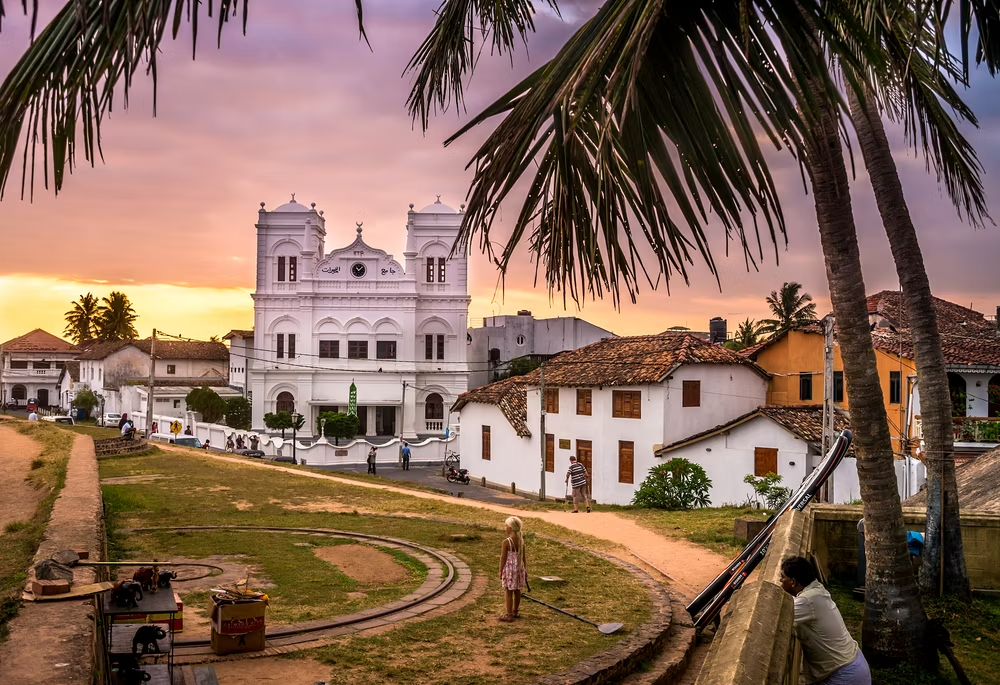- Galle Fort in Sri Lanka is one of the largest and oldest European-era forts in South and Southeast Asia, built by the Portuguese in 1588 and later fortified by the Dutch before British occupation.
- Galle, a busy port since ancient times, had a long colonial history with Portuguese, Dutch, and British dominance, shaping its architectural heritage and importance.
- Today, Galle Fort is a UNESCO World Heritage site, showcasing the interaction between European architecture and South Asian traditions, with guided tours and a mix of cultural influences in Galle City.
The large Galle Fort in Sri Lanka is one of the largest and oldest European-era forts in South and Southeast Asia. The Galle Fort was first built by the Portuguese in 1588 (the same year as the Spanish Armada sailed against England). It was later extensively fortified by the Dutch before the British took over the island.
Sri Lanka is famous for its tropical beaches and timeless landscapes, and there are many reasons to visit Sri Lanka. The tropical island of Sri Lanka is a memorable place to visit with ancient attractions and natural wonders galore. Start at the Galle Fort in Sri Lanka.
The Long Colonial History Of Galle Fort In Sri Lanka

Historical buildings & architecture inside the Galle Dutch fort
Sri Lanka achieved independence in 1948 from the British. But before the British, the Portuguese and the Dutch had established forts and dominated some of the coastal parts of the country (although they never fully controlled the interior of the country).
Galle Fort dates from the earliest times of European colonialism in the region. The fort was first built by the Portuguese in around 1588, before the first successful English settlement in the United States (Jamestown in 1607).
- First Built: Approx. 1588
- Expanded: 17th century (after 1649)
Sri Lanka’s port of Galle was first recorded on an ancient Greco-Roman map by Claudius Ptolemy on his world map between 125 and 150 AD. Even back in those times, Galle was a busy port that traded with ancient Greece, Arab countries, China, and other places.
- Portuguese Period: Early 16th century to mid-17th century
- Dutch Period: mid-17th century to 1796
- British Period: 1796 to 1948
The Portuguese first landed there in 1505. They started to fortify the fort but then moved to Colombo (today the capital and largest city of Sri Lanka). But after the Sinhalese attacks on the Portuguese there, they returned to Galle.

Old colonial settlement of Galle, Sri Lanka
The Dutch, with a force of around 2,500 men, managed to capture Galle Fort in the mid-17th century (during this period, the Dutch and Portuguese were colonial rivals across Asia, Africa, and the Americas). Many of the buildings seen at Galle Fort today date from the Dutch period.
The Dutch period came to an end in 1796 when the British took over the fort. The British extended their control and took over the interior of the island in 1815 (see Kandy – the historic capital of Sri Lanka in the center of the country) and then ruled Sri Lanka until its independence in 1948.
The British developed Colombo as the main capital and port of Sri Lanka and so Galle’s importance declined. The fort had an epilogue in World War Two when fortifications were built and installed to defend the fort against the Japanese.
Galle Fort & Galle City Are Unique Attractions In Sri Lanka
Today Galle Fort is one of the great historical and architectural heritage monuments in Sri Lanka. Thanks to extensive reconstruction over the years, the over-430-year-old monument remains in a great state of repair.
Galle Fort is now UNESCO World Heritage Listed for being “an urban ensemble which illustrates the interaction of European architecture and South Asian traditions from the 16th to the 19th centuries.”

Galle is considered the best example of a European-colonial fortified city in South and Southeast Asia. It shows interactions between European architectural styles and South Asian traditions.
- Fortifications Walls: Mostly Date From 1663
- Sea Walls: Completed 1729
Galle is a developed tourist destination with beaches, historic monuments, and plenty of guided tours available. Galle City itself is a small city of around 112,000 inhabitants that developed around the fort. The inhabitants are a mix of descendants of Sinhalese, Moors, Dutch, English, German, and Portuguese who arrived there.
Source: https://www.thetravel.com/what-is-special-about-galle-fort-sri-lanka/
